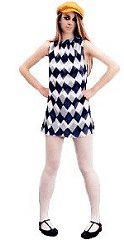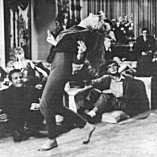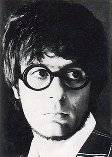 |

|
|
|
The
Sixties didn't just
happen in the UK! Personal reminiscences from Paul Gabor His view of life in Hungary in the Sixties |
 |
'All
Dressed Up'
The Sixties and the Counter Culture by Jonathon Green |
 |
'
Mod - A Very British
Phenomenon' by Terry Rawlings, Chris Charlesworth |
Sixties
City
Look for more Sixties Items in 
|
              |
The
'beatnik' (this is the word Herb Caen coined for the Beat Generation
in the spring of 1958 - insiders called themselves 'beats') culture
of the early sixties was in some ways a kind of keyed-down precursor
to the 'hippie' movement (again, 'hippie' is an outsiders name (much
like beatnik), 'freak' is the insiders name) . It had its beginnings
in Paris's St. Germaine quarter and was originally the Left Bank movement
of writers such as Jack Kerouac, Allen Ginsberg and Lawrence Ferlinghetti.
Made more popular by 'style' models such as Juliette Greco and Brigitte
Bardot it attracted, mainly, more intellectual middle and upper-class
'dropouts' who wanted to throw off their class trappings by adopting
their own strange vocabulary and laid-back bohemian attitude, frequenting
low-lit 'cellar' clubs and indulging their love of jazz and blues
music.
Another highly popular element around the music scene in the early Sixties were what are generically known as 'Irish Showbands', although this did not reflect in chart recording successes. Groups such as The Impact Showband and The Jivenaires often appeared as supporting acts to major chart-topping artists and groups at concerts in both the U.K. and the U.S.A. The arrival of the Mersey sound in 1962-3, notably the Beatles, and other influential groups such as the Rolling Stones, the Animals and later, of course, the Who, led to a rapid rise and growth in the cultural group - the mods - ( short for modernists ) who seemed to come into being almost overnight but who had been around among the fringe groups following modern jazz. A curiously British phenomenon, their culture revolved mainly around dancing, fashion and music, taking little notice, publicly, of girls. In order to get the
energy for their 24 hour dance-til-you-drop lifestyle, mods popularised
the perceived common use of drugs. There was always something happening
somewhere and the Mod drug of choice, amphetamine, kept them going
for days. Although available, marijuana did not fit in with the
Mod culture as it had the effect of 'slowing down' not 'speeding
up'. It is the modern perception that the Sixties youth society
was rife with substances of various sorts, and there is no doubt
that they were becoming increasingly available, particularly towards
the close of the decade, but the fact is that they were generally
pretty hard to get hold of and the actual overall usage was comparatively
very low compared to today.
With 'their own' music,
fashions, dances and chosen method of transportation, the Italian
'scooter', friction inevitably began to arise between the mods and
the die-hard rock'n'roll, motorcycle culture of the rockers as they
were progressively ousted from their traditional haunts. To Rockers,
Mods were effeminate, weedy, 'posh' snobs. The Mods viewed Rockers
as being anachronistic, loutish and dirty. Generally speaking, the
Mod movement was based in the major cities, particularly rooted
in London, whereas Rockers tended to be more rural. Mods had comparatively
well-paid office jobs while Rockers were working class and the antagonism
even stretched to musical tastes where there was virtually no common
element.
The
standard mod 'uniform' of the time consisted (for the average Mod)
of the American 'parka' style coat with fur-trimmed hood for protecting
their expensive shiny two-tone mohair suits while riding their highly
decorated and customised scooters. 'Aces' or the richer, highly
fashionable Mods wore full length leather coats. Other affectations
were 'Fred Perry' or small collar shirts, narrow ties and the famous
'winklepicker' toed shoes or elastic-sided 'Chelsea' boots, although
there were variations on this theme as fashion changed so rapidly.
American shirts (tab and button down) could be bought from an American
Gents Outfitters on Shaftesbury Avenue for £59/11 (£2.98p) and Madras-striped
cotton jackets were hunted for at various out of the way shops according
to 'locals' knowledge. Rare 'white' Levi jackets could be acquired
from a ships' chandlers in the East End along with a consignment
of J.C. Penney's 'Harrington' jackets. Other favourites were red
wool 3-button shirts, continental cycling jerseys and Italian 'driving-shoes',
a type of loafer with a rubber heel back made by Ravel. Various
styles came and went: round-toed, almond-toed, chisel-toed, winklepickers
with the points chopped off.
The main popular haunts were centred around the West End, particularly Soho, in clubs like The Scene, The Scotch, The Ad-Lib, The Ram Jam, The Crazy Elephant, La Discotheque and The Flamingo where the resident band were Georgie Fame and The Blue Flames. Another top mod hangout was The Goldhawk Club in Shepherd's Bush. Top mods, the ones responsible for initiating fads or changes in style were known as 'faces' and often used mascara and eye make-up to enhance their looks. There was quite a hierarchy in the mod movement and various factions were known as 'stylists', 'individualists', 'numbers', 'tickets', 'mids', 'mockers', 'seven and sixes', 'states', 'moddy boys' and 'scooter boys', amongst others. Constantly driven by changing music and fashion tastes and styles, the mods appeared to diverge fairly rapidly back into their various sub-cultures dependent on their individual or group preferences. After 'mod' there followed
a comparatively brief period of 'Regency', which was a 'Beau Brummel'
look using Buttons, bows, velvet and frills, epitomised by the dress
of some of the major pop groups such as The Kinks and The Walker
Brothers during 1966-67, and also the photographer Patrick Litchfield.
Although these movements and fashions survived to some extent late
into the decade they were eventually swamped by the huge influence
of the hippie psychedelic 'flower power' culture of the mid to late
Sixties by which time a new generation of teenagers were making
their own individualism and preferences apparent.
Pop-art was a movement
that emerged in the late Fifties as a reaction to the seriousness
given to abstract impressionism. It attempted to fuse elements of,
and remove boundaries between, popular and high culture. The main
exponents of pop-art, spearheaded by artists such as Peter Blake
and Robert Rauschenberg, were Roy Lichtenstein, Allen Jones, Tom
Wesselman, John McHale and, of course, Andy Warhol and David Hockney.
Their style was simplistic, reducing a subject to its lowest common
denominator and then converting it with exaggerated colour to express
abstract formal relationships.
Andy Warhol also diversified
into the film industry where he gave us a 3 hour silent film of
a man sleeping, called 'Sleep' and an 8 hour view of the Empire
State building called - you guessed it - 'Empire'. Apart from these,
he produced 'Kiss', 'Blow-Job', 'Flesh', 'Harlot' and 'Trash' and
also gave us Edie Sedgwick, Nico and Velvet Underground. The 'underground'
press that thrived in Europe and America from around 1966 were also
influencing or being influenced by this. One of the most famous
underground magazines was 'OZ', created by Richard Neville, which
featured humorous or satirical articles by young authors such as
Clive James and Germaine Greer. The various publications became
a channel for youth to produce its own alternative to the more ordinary
magazines on sale and led the way for a sub-culture of 'underground'
groups, festivals and films.
The
year, the date, the hour I remember vividly. It was on a November
Saturday evening, about 6 o'clock. We, The Funny Fools - yet only
No.2 position on the popularity vote, -for creating mass-hysteria
comparable to that of The Beatles far away - were to play a ball-event
at the big leather-processing factory's ballroom in my hometown,
southwest Hungary. |
              |
|
|
UK
Web Hosting by
Velnet web
hosting UK | Search
Engine Optimisation & Submission by Submit
Express
Web Address Domain Names from Web Hosting Shop |
All
original material
|











